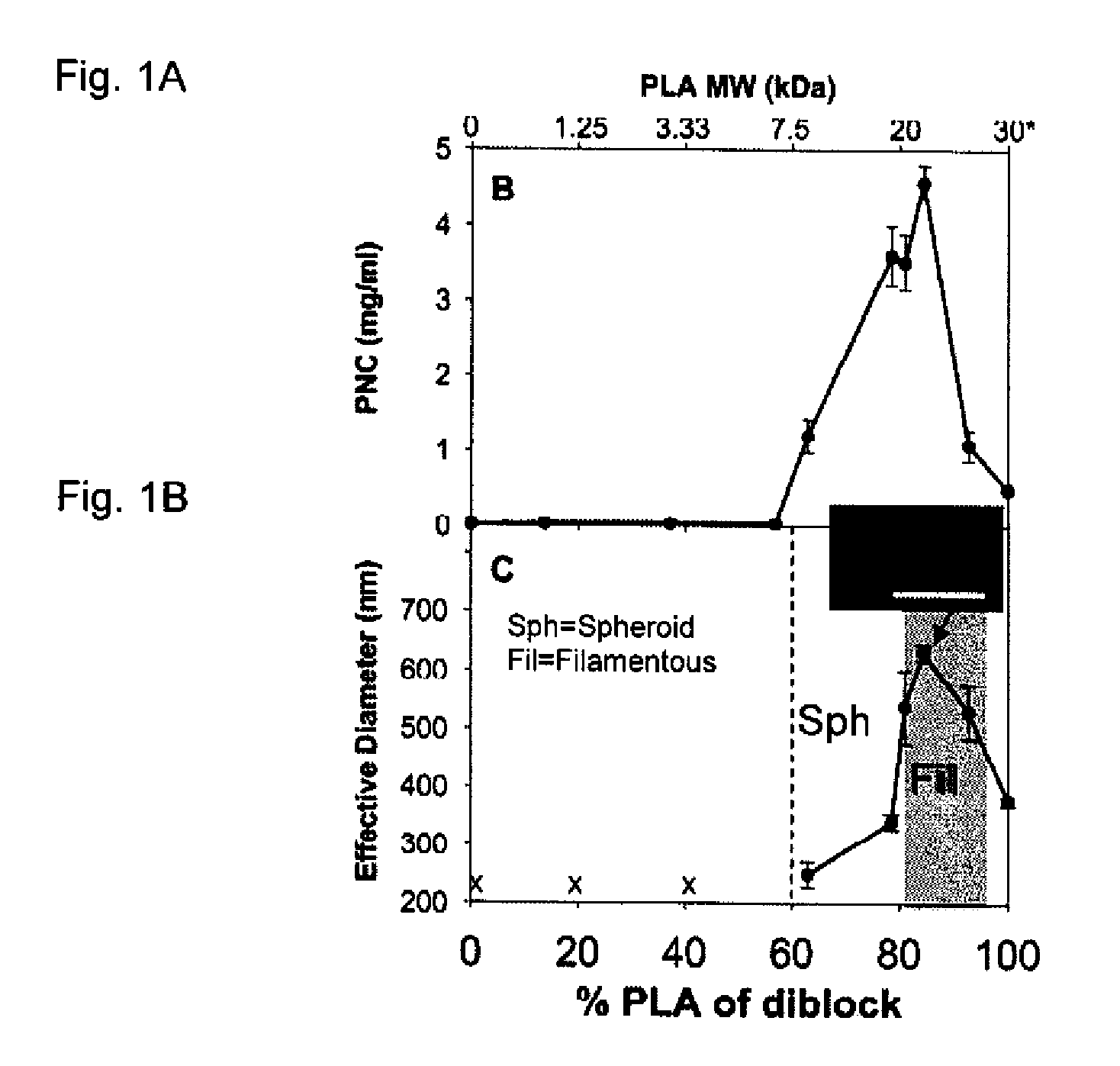Method and Compositions for Polymer Nanocarriers Containing Therapeutic Molecules
a technology of nanocarriers and therapeutic molecules, applied in the direction of biocide, microcapsules, peptide/protein ingredients, etc., can solve the problems of complex structure, limited utility of potent but labile therapeutic proteins, and low affinity for desired target sites, etc., to achieve the effect of facilitating the delivery of therapeutic proteins and reducing the affinity of desired target sites
- Summary
- Abstract
- Description
- Claims
- Application Information
AI Technical Summary
Benefits of technology
Problems solved by technology
Method used
Image
Examples
example 1
Synthesis of Diblock Copolymers
[0087]DL-lactide was re-crystallized twice in anhydrous ether, before mixing with methoxy poly(ethylene glycol) (mPEG) MW 5,000 (Polysciences, Warrington, Pa.) in stoichiometric ratios to achieve desired molecular weights. Reactants were heated to 140° C. under nitrogen while stirring for 2 hours to remove trace water from samples. The temperature was reduced to 120° C. and stannous octoate (1 wt %) was added to catalyze the ring opening polymerization (ROP) of lactide with mPEG as the initiator. The polymerization was allowed to continue for 6 hours. The diblock copolymer was then dissolved in dichloromethane (DCM) and twice precipitated in cold diethyl ether. Residual solvent was then removed by first drying via rotary evaporation (SAFETY VAP® 205 system, Buchi, Switzerland), followed by lyophilization (RCT 60, Jouan, Winchester, Va.).
[0088]Number average molecular weights ( Mn) of bulk copolymers were determined using proton nuclear magnetic resonan...
example 2
Nanoparticle Formation
[0092]A freeze-thaw double emulsion solvent evaporation technique was used as previously described in Dziubla et al 2005 cited above and US Patent Application Publication No. 2006 / 0127386. Briefly, mPEG-PLA diblock copolymer is dissolved in DCM at 25 mg / ml. A 1 mg / ml bovine liver catalase (242 kDa) (Calbiochem, EMD Biosciences, San Diego, Calif.) solution and a polyvinyl alcohol (PVA) surfactant solution (2 wt %, 87-89% hydrolyzed, Mw=13,000-23,000) in 20 mM PBS are prepared. The primary emulsion consisted of the organic phase (1 ml polymer—DCM mixture) and the aqueous phase (100 μl catalase solution) homogenized at 15 krpm for 1 minute in a dry ice-acetone bath with a 7 mm—blade homogenizer (KINEMETICA POLYTRON 3100 instrument with a PDTA3007 / 2 generator, Brinkmann Instruments, Westbury, N.Y.). The primary emulsion was then added to 5 ml of the PVA surfactant solution and homogenized at 15 krpm for 1 minute. The resultant mixture was added to 10 ml of PVA solu...
example 3
Enzyme Loading Determination
[0093]Protein loading was determined via radioisotope labeling and enzymatic activity. Loading via radiolabeling was determined as described before, by formulating PNC with 125I-labeled catalase following the directions of the above-referenced in Dziubla et al 2005 cited above. Catalase was radiolabeled with Na125I (Perkin Elmer, Boston, Mass.) via the Iodogen method (Pierce Biotech., Rockford, Ill.). Unbound 125I was removed from catalase using BIOSPIN 6 columns in accordance with the manufacturer's instructions (Bio-Rad labs, Hercules, Calif.). Total solution 125I-catalase content was measured before centrifugation, and then radioactivity of the 125I-catalase / PNC-composed pellet after centrifugation was measured. A WIZARD 1470 gamma counter (Wallac, Oy, Turku, Finland) was used for radiotracing.
[0094]To determine loading via enzymatic activity, a catalase activity assay (Shuvaev, V. V. et al, Methods Mol Biol 2004, 283: 3-19) was used, both for the tota...
PUM
| Property | Measurement | Unit |
|---|---|---|
| molecular weight | aaaaa | aaaaa |
| molecular weight | aaaaa | aaaaa |
| length | aaaaa | aaaaa |
Abstract
Description
Claims
Application Information
 Login to View More
Login to View More - Generate Ideas
- Intellectual Property
- Life Sciences
- Materials
- Tech Scout
- Unparalleled Data Quality
- Higher Quality Content
- 60% Fewer Hallucinations
Browse by: Latest US Patents, China's latest patents, Technical Efficacy Thesaurus, Application Domain, Technology Topic, Popular Technical Reports.
© 2025 PatSnap. All rights reserved.Legal|Privacy policy|Modern Slavery Act Transparency Statement|Sitemap|About US| Contact US: help@patsnap.com



